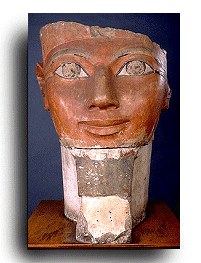 Click on the cartouche to view some of the numbers and fractions used by the Egyptians.
Click on the cartouche to view some of the numbers and fractions used by the Egyptians.
Luxor & the Valley of the Kings!
I flew into Luxor from Cairo in the late afternoon and the weather was perfect, about 75 degrees and clear skies. Boarded our river boat and then proceeded to sight see in Luxor.
Karnack is on the banks of the Nile and is one of the most awe-inspiring religious buildings on earth. From here is an avenue lined (originally two miles long) with sphinxes which runs south to Luxor. The ancient name for this place was Thebes which embraced present-day Karnack and Luxor and across the Nile in western Thebes, the tombs and mortuary temples of the pharaohs in the Valley of the Kings and Queens. This area was the heart of Egypt from 2100 to 750 BCE. On the east bank was the city of the living in the direction of the sun rise. On the west bank, in the direction of the sun set, was their necropolis. The Nile gave Egypt life and the Sun God Re sailed his ship to the underworld each night.
The temple of Amun at Karnack is reckoned by many to be the most unforgettable experience that the ancient sites of Egypt have to offer.
Note:
While visiting this and other temples you might want to see if you can understand any of the
hieroglyphic, especially the numbering system.
 Click on the cartouche to view some of the numbers and fractions used by the Egyptians.
Click on the cartouche to view some of the numbers and fractions used by the Egyptians.
This temple was begun in the 'Middle Kingdom' dynasties of Egypt around 1900 BC, it continued to develop and grow around the central temple throughout the remainder of Ancient Egyptian history. It was the central place of worship of the god Amun, who became the 'state' deity and building works here were carried out by, amongst others, Hatchepsut, Tutmoses III, Tutankhamun,Horemheb, Seti I and Ramesses II. It was the wealthy and powerful priesthood that lived and worshiped here whom the 'heretic' king Akhenaton attempted to overthrow. However, such was the power of the priesthood, that shortly after his death the young king Tutankhaten changed his name to Tutankhamun and restored the worship of Amun as the state religion. The temple covers an area of roughly 400,000 square meters and its scale can only be appreciated by visiting the site, photographs and video's are incapable of doing it justice. It has been calculated that the El-Karnack would comfortably hold seven Notre Dames with room left for St. Pauls Cathedral! Here are more details about the Temple of Karnak for you to review.
We next went across the Nile to the Valley of the Kings and Queens and walked up the ancient paths through the dry and dusty valleys where thousands of years ago the Pharaohs were taken to their secret burial sites. In 1344, King Tutantkamun was buried in a very small tomb, probable for an official rather than a pharaoh, about 30 steps down into the main room, seemed only about 12 by 20 feet and then a separate room with the pink quartz sarcophagus and wall paintings of the procession to the grave site. There is a small room off on the side and these few rooms were filled with treasures that now are housed on the second floor of the Cairo Museum. The tomb had to be packed to get that many things into such a small area! King Tutantkamun is the only pharaoh (mummy) buried in the valley as all of the others are lost or in the museum. We also went into several other tombs, Ramses tomb has paintings that look like new and we always wonder how the painters lit the rooms when they were so far under ground. The colors are still beautiful and ceilings covered with stars and gods hovering over the mummy in a protective manner.
 Click on the picture and read about Queen Hatshepsut's reign in detail if you want all of the facts associated with her
ascension to the throne and her inclusion into the ranks of Pharaohs and Gods!
Click on the picture and read about Queen Hatshepsut's reign in detail if you want all of the facts associated with her
ascension to the throne and her inclusion into the ranks of Pharaohs and Gods!
Next to see Queen Hatshepsut's Mortuary Temple, one of the most interesting buildings in Egypt, actually one of the most dramatic and she is probably one of the most interesting woman in history. Her rule over Egypt was one of artistic growth, exploration of new lands and architectural wonders.
Now it is time to leave Luxor and the Valley of the Kings and commence on our voyage up the Nile to Aswan.